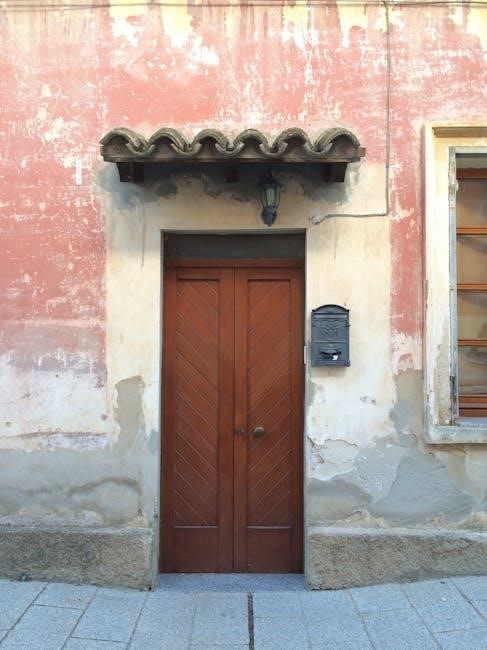Doors are essential elements in both residential and commercial spaces, serving as gateways that influence security, privacy, and aesthetic appeal. This guide provides an in-depth exploration of door types, materials, hardware, and maintenance tips, ensuring functionality and design align with modern needs and sustainable designs for energy efficiency.
Understanding the Importance of Doors in Home and Commercial Spaces
Doors are gateways that significantly influence security, privacy, and aesthetic appeal in both homes and commercial spaces. They serve as the first point of entry, shaping initial impressions while providing protection and energy efficiency. In homes, doors enhance personal space and comfort, while in commercial settings, they reflect branding and customer experience, making their design and functionality critical to overall space utility and ambiance.
Overview of Door Types and Their Purposes
Doors vary widely in design and functionality, catering to different needs. Interior doors enhance privacy and room separation, while exterior doors prioritize security and durability. Specialty doors, like sliding or folding options, save space and offer unique aesthetic solutions. Each type serves specific purposes, balancing functionality, security, and style to meet the demands of modern living and commercial environments effectively.

Types of Doors
Doors are categorized into interior, exterior, and specialty types, each serving unique purposes. Interior doors focus on privacy, while exterior doors emphasize security and durability. Specialty doors, like sliding or folding options, offer space-saving solutions and aesthetic appeal, catering to diverse architectural and functional needs.
Interior Doors: Styles and Functionalities
Interior doors come in various styles, including panel, glass, and flush designs, each offering unique aesthetic and functional benefits; They provide noise reduction, privacy, and space-saving solutions, while enhancing the overall interior design. Functionalities range from sliding mechanisms to soft-close features, ensuring durability and ease of use. These doors are tailored to meet specific room requirements, blending seamlessly with modern and traditional interiors alike, ensuring both practicality and style.
Exterior Doors: Materials and Security Features
Exterior doors are crafted from durable materials like steel, fiberglass, and wood, offering strength and weather resistance. Security features include robust locking systems, metal frames, and impact-resistant glass. Advanced technologies like smart locks and biometric systems enhance safety. These doors are designed to protect homes from external threats while maintaining energy efficiency and aesthetic appeal, ensuring long-lasting performance and peace of mind for homeowners.
Specialty Doors: Sliding, Folding, and Pocket Doors
Specialty doors offer unique solutions for space-saving and modern design. Sliding doors glide smoothly on tracks, ideal for connecting indoor and outdoor spaces. Folding doors stack neatly, creating open layouts. Pocket doors disappear into walls, maximizing room efficiency. These options are perfect for contemporary homes, blending functionality with sleek aesthetics to enhance living areas while minimizing space usage effectively.
Historical and Modern Door Designs
Door designs have evolved from ancient simplicity to modern sophistication. Historical doors often featured intricate carvings and heavy materials, reflecting craftsmanship and status. Modern designs prioritize minimalism, with sleek lines and innovative materials like glass and metal. This blend of tradition and innovation ensures doors remain functional while serving as statement pieces in contemporary and heritage settings alike, adapting to diverse architectural styles seamlessly.

Door Materials and Finishes
Door materials range from traditional wood to modern steel and glass, each offering unique benefits. Finishes like paints, stains, and laminates enhance durability and aesthetic appeal, ensuring doors complement both classic and contemporary designs while providing functionality and style.
Wooden Doors: Benefits and Maintenance Tips
Wooden doors offer timeless elegance and durability, blending naturally with various interior designs. Regular polishing enhances their appearance, while sealing protects against moisture. Avoid harsh chemicals and extreme temperatures to maintain their integrity. Proper care ensures longevity, preserving the natural beauty and strength of wooden doors for years to come.
Steel and Metal Doors: Durability and Security
Steel and metal doors are renowned for their exceptional durability and robust security features. Constructed from high-strength materials, they provide excellent resistance to forced entry and harsh environmental conditions. These doors are often insulated, enhancing energy efficiency and reducing noise. With minimal maintenance, they offer long-lasting performance, making them ideal for both residential and commercial applications where safety and strength are priorities.
Glass Doors: Aesthetic and Functional Considerations
Glass doors enhance spaces by combining elegance with functionality. They allow natural light, creating a sense of openness while maintaining privacy. Available in framed or frameless designs, they complement modern interiors. Energy-efficient options reduce heat transfer, and tempered glass ensures safety. Proper sealing prevents air leaks, making them ideal for homes, offices, and commercial areas seeking a blend of style and practicality.
Composite Materials: A Modern Approach to Door Construction
Composite materials blend wood, metal, and synthetic elements, offering durability and low maintenance. These doors resist rot, warping, and pests, making them ideal for harsh environments. They provide excellent thermal insulation, reducing energy costs. Modern designs combine aesthetics with functionality, catering to both residential and commercial needs for a versatile and sustainable solution in door construction.

Door Hardware and Accessories

Door hardware and accessories, like handles, locks, and hinges, enhance functionality and security. They ensure smooth operation and provide essential features for safety and convenience in daily use.

Handles and Knockers: Choosing the Right Style
Handles and knockers are crucial for both functionality and aesthetics. They come in various styles, from modern levers to traditional knobs, and decorative knockers. Choosing the right style involves considering durability, ease of use, and compatibility with your door’s design. Ensure they complement the overall aesthetic while providing secure and smooth operation, reflecting personal taste and enhancing curb appeal effectively always.
Locks and Security Systems: Ensuring Safety
Locks and security systems are vital for safeguarding homes and businesses. High-quality locks, such as deadbolts and smart locks, offer enhanced security. Additionally, integrated systems with biometric technology and surveillance cameras provide advanced protection. Regular maintenance and upgrading outdated systems are essential to ensure reliability and prevent unauthorized access, guaranteeing peace of mind and protecting valuables effectively always.
Hinges and Door Closers: Mechanisms for Smooth Operation
Hinges and door closers are crucial for ensuring smooth and efficient door operation. Hinges provide structural support, while door closers control the opening and closing motion. Proper installation and maintenance of these components are essential for longevity and functionality. Durable materials and adjustable settings help customize performance, ensuring doors operate seamlessly and quietly, enhancing user experience and overall satisfaction consistently over time.
Other Accessories: Peepholes, Door Chains, and More
Peepholes, door chains, and other accessories enhance security and functionality while adding convenience to daily use. These components provide essential safety features, allowing residents to screen visitors while maintaining privacy. Durable materials ensure longevity, while sleek designs complement various door styles, making them indispensable additions for any home or commercial space, ensuring both security and aesthetic harmony seamlessly every day.

Door Installation and Maintenance
Proper door installation ensures alignment and functionality, while regular maintenance, like hinge lubrication and gap sealing, prolongs longevity and ensures smooth operation over time.
Step-by-Step Guide to Installing a Door
Start by preparing the doorway, ensuring the frame is level and secure. Attach hinges to the door and frame, then hang the door. Install hardware like handles and locks. Add weatherstripping for sealing. Finally, test the door’s alignment and operation to ensure smooth functionality and proper fit.
Common Door Problems and How to Fix Them
Doors often face issues like squeaky hinges, misalignment, or damaged frames. Lubricate hinges with silicone spray or oil for squeaks. Adjust hinges or plane the door edge for alignment. Replace worn-out weatherstripping to prevent air leaks. For damaged frames, use wood filler or replace severely damaged sections. Regular maintenance ensures smooth operation and longevity of your doors.
Regular Maintenance Tips for Longevity
Regularly inspect and clean door tracks and hinges to ensure smooth operation. Lubricate hinges with silicone-based sprays to prevent squeaking. Tighten loose screws and replace worn-out weatherstripping to maintain energy efficiency. For wooden doors, apply a protective finish to shield against moisture and wear. Consistent care extends the lifespan and performance of your doors, keeping them functional and visually appealing over time.

Energy Efficiency and Door Performance
Doors play a crucial role in home insulation and energy efficiency by minimizing heat transfer and air leaks. Properly sealed doors help reduce energy costs and maintain consistent indoor temperatures, contributing to a more sustainable and eco-friendly living space.
How Doors Impact Home Insulation and Energy Costs
Doors significantly influence home insulation by controlling heat transfer and air leakage. Poorly insulated doors can lead to energy losses, increasing heating and cooling costs; Proper weatherstripping and sealing are essential to prevent air leaks, while energy-efficient materials like foam cores or thermal breaks enhance insulation performance, reducing energy consumption and lowering utility bills over time.
Choosing Energy-Efficient Door Materials
Selecting energy-efficient door materials is crucial for minimizing heat transfer and reducing energy costs. Materials like insulated steel, fiberglass, and thermally broken aluminum offer excellent thermal performance. Additionally, composite materials blend durability with energy efficiency, while low-E glass enhances insulation by reflecting heat rather than absorbing it, making these options ideal for eco-conscious homeowners seeking to optimize their home’s energy performance and sustainability.
Weatherstripping and Sealing: Preventing Air Leaks
Weatherstripping and sealing are essential for preventing air leaks around doors, enhancing energy efficiency. Materials like foam tape, felt, or vinyl create a tight seal when doors close. Proper installation ensures insulation, reduces heat loss, and minimizes drafts. Regular maintenance, such as replacing worn seals, helps maintain energy savings and prevents moisture damage, ensuring doors function optimally year-round.

Door Safety and Security
Door safety and security are critical for protecting lives and property. Fire-rated doors, strong locks, and emergency exits ensure safety and prevent unauthorized access, enhancing overall protection.
Fire-Rated Doors: Protecting Lives and Property
Fire-rated doors are designed to withstand fire for specific durations, ensuring safety and property protection. They are made from materials like solid core wood or metal, sealed with fire-resistant components. These doors must comply with building codes and undergo regular inspections to maintain their effectiveness in emergencies. Their role in containing fires and safeguarding escape routes is crucial for occupant safety.
Security Features for Residential and Commercial Doors
Modern doors incorporate advanced security features such as multi-point locks, deadbolts, and reinforced frames to prevent unauthorized entry. Smart locks with biometric authentication and digital keypads enhance convenience and safety. For commercial settings, anti-pick pins and tamper-proof hinges are common, ensuring maximum protection against potential breaches. These features help safeguard both homes and businesses effectively.
Emergency Exit Doors: Compliance and Safety Standards

Emergency exit doors must comply with strict safety regulations to ensure quick evacuation during crises. Features like panic bars, clear exit signs, and easy-opening mechanisms are mandatory. Regular inspections and maintenance are required to guarantee functionality. These doors play a critical role in saving lives, adhering to fire safety standards, and providing reliable escape routes in emergencies.
Future Trends in Door Technology
Innovative door technologies are transforming spaces. Smart doors integrate with automation, offering touchless operation. Biometric locks enhance security, while eco-friendly materials improve energy efficiency.
Smart Doors: Integration with Home Automation Systems
Smart doors seamlessly integrate with home automation systems, offering enhanced convenience and security. Touchless entry and remote monitoring are now possible. Voices commands enable hands-free operation. These systems improve energy efficiency by optimizing door usage and provide real-time alerts for unusual activity, ensuring a safer and smarter living environment. Biometric locks and self-locking mechanisms are set to redefine future door technology.
Sustainable and Eco-Friendly Door Materials
Modern door construction increasingly incorporates eco-friendly materials, such as recycled wood, bamboo, and aluminum. These options reduce environmental impact while maintaining durability. Composite materials blending natural fibers with recycled plastics are also gaining popularity. Such sustainable choices not only support green building practices but also contribute to energy efficiency and lower long-term maintenance costs, aligning with global environmental goals.
Biometric Door Locks: The Future of Access Control
Biometric door locks represent a leap forward in access control, offering unparalleled security and convenience. Using fingerprint or facial recognition, these systems eliminate the need for keys or codes. They provide enhanced security by ensuring only authorized individuals gain entry. Advanced models integrate with smart home systems, allowing remote monitoring and control. This technology is poised to revolutionize how we secure and access spaces, blending convenience with cutting-edge security.
